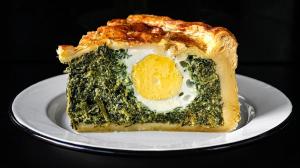The Catholic and Protestant Easter festivities take place over one month earlier before the Orthodox Easter, which is the one I culturally celebrate as a Greek, giving me enough time to experiment with an Italian Easter dish which originally dates from the 16th century, but with a few personal 21st century improvements, which I hope you’ll enjoy !
Obviously, it reminds me of a Greek SPANAKOPITA, but much thicker (at least 3 times thicker) and without the salty and briny feta cheese which gives spanakopita a particular kick.
The magic and particularity of this Italian Easter TORTA PASQUALINA pot pie are the extra whole eggs, added raw and whole in deep indents inside the prepared pie filling and which bake at the same time as the rest of the assembled pie and provide visual and textural differences from slice to slice and bite to bite, without becoming dry and rubbery from overcooking.
The partly cooked spinach mixture is combined with green onions, celery and/or fennel and then mixed with different cheeses, from the creamy and neutral ricotta, to the stringy mozzarella and the drier, saltier and sharper parmesan and pecorino and a few beaten eggs are added to the mixture, to bind it all loosely.
I add lots of dill and parsley to the mixture as well as a combination of ground fennel, anise and dill seeds too and green peppercorns which gives it a more enticing and fresh “spring” flavor.
The whole raw eggs, in the indents of the filling, should be added according to the number of slices you’d like to serve. I’ve added 6 here for 6 slices but there’s no reason not to add only 5 for 5 bigger slices or up to 8 eggs for 8 smaller slices.
The important thing about the pastry, which could be buttery puff-pastry or something similar using olive oil instead, is its shaping. It’s a pot pie or a double-crust pie which means a top crust, a bottom crust and the sides but be sure that the top crust has holes in it, for the steam to escape but also to indicate where the eggs are and where you’d like to slice it.
I line up the round and ringed vents in the top crust with the middle of the eggs and then place smaller circles or pastry dots exactly in between, so I know where to slice the pie, to end up with a half egg on each side of the slice. It’s more impressive and prettier. And there’s an extra hole in the middle too, to balance it all out.
Happy “first & early” Easter to all … :)





















